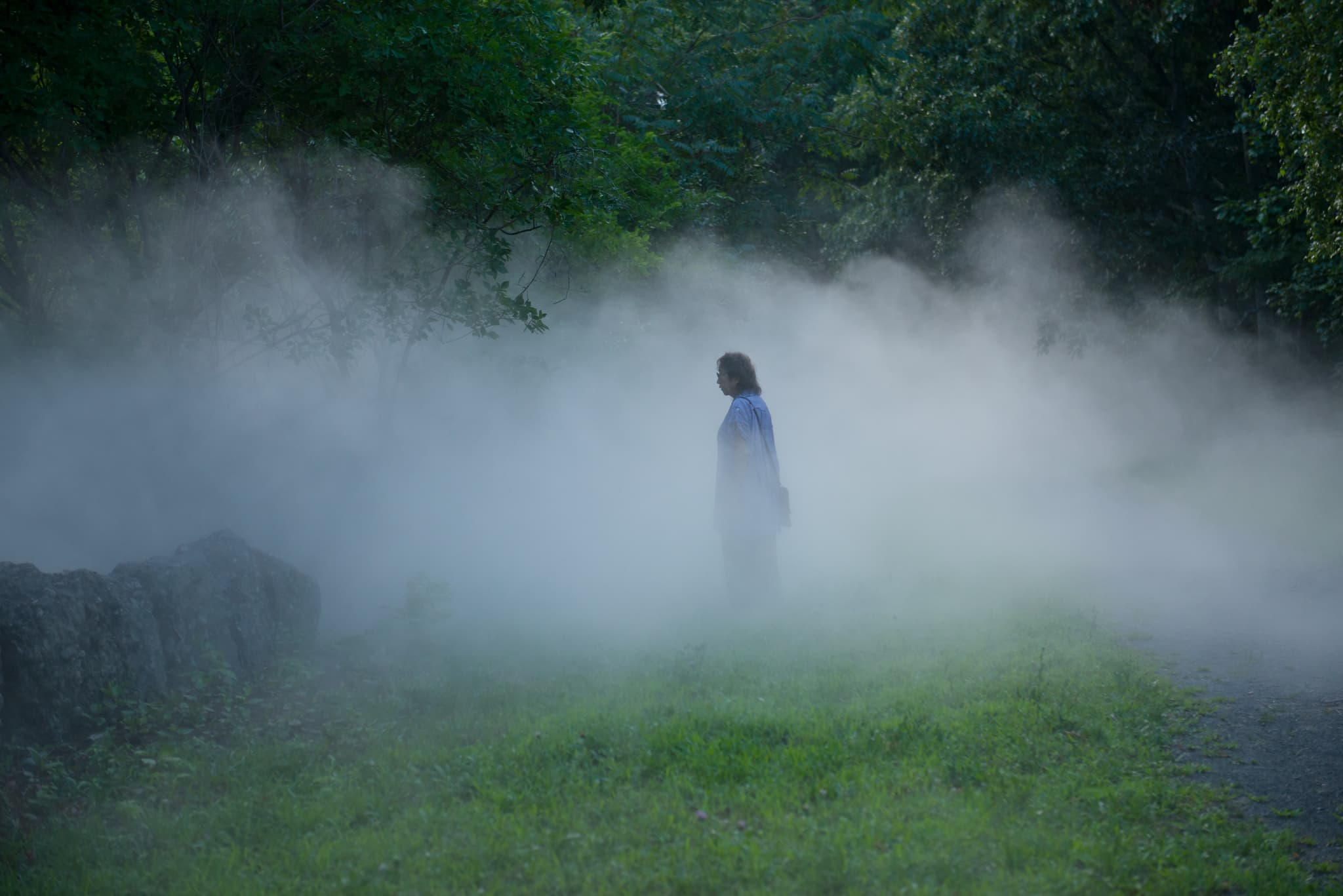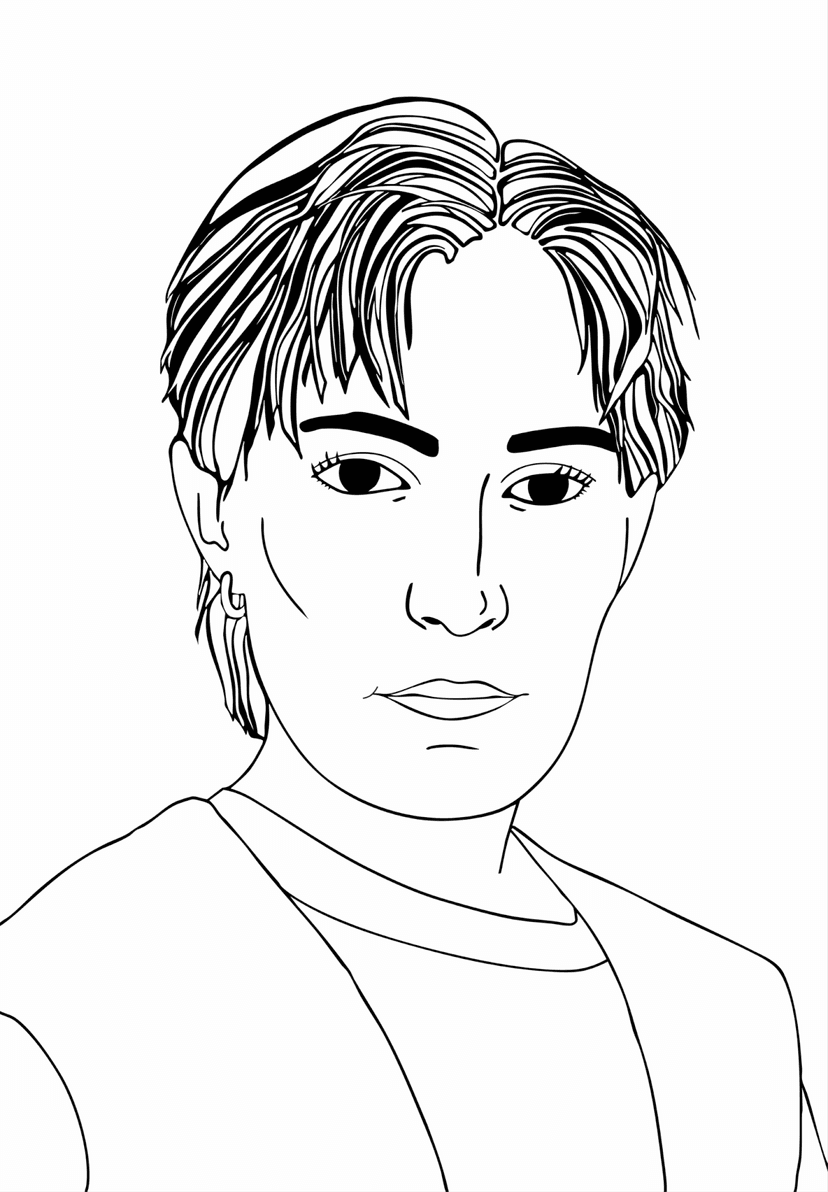It is a seldom occurrence that an artist is so inextricably detached from the categorization of her medium. Japanese artist Fujiko Nakaya has become most renowned for her mastery of fog as a medium that both transcends and exists between the realms of space, movement, reflexivity, and time. Yet, the same qualities that are said of her sculptures could be said of the artist herself, whom for many decades has played a key role in several of the artistic movements canonized in Japanese and Western Post-War Contemporary Art. Emerging with avant-garde artists of the 1960s, Nakaya’s expansive body of work could be deemed a pillar of conceptual, installation, and site-specific art. Though, until recent years, Nakaya’s contributions to these artistic practices have been significantly overshadowed by her male contemporaries—an all too familiar injustice.
In Miwon Kwon’s 1997 essay “One Place after Another: Notes on Site Specificity” she explores the dynamics of art that is rooted in ecological and social interactions, wherein the site and processes together become a medium.(1) The essay attempts to categorize a paradigm, yet in doing so, somewhat fails to recognize the nuance of artistic practices and overlooks key individuals. Fujiko Nakaya, whose work is emblematic of the discourse presented in Kwon’s essay, is simply not included. And in Martha Bushkirk’s book “The Contingent Object of Contemporary Art,” she examines materiality, methods, and mediums of 1970s artists, but still, no mention of Fujiko Nakaya.(2) These are just a couple of examples where as a writer I struggled to grasp why her work had not been included. After conducting my own research, I started to jump to my own conclusions. Perhaps Nakaya is just too prolific, too collaborative, or works between too many mediums. Perhaps she was too busy organizing multi-artist exhibitions in several countries, overseeing a conceptual video art gallery in Japan, and creating dozens of installations throughout the 1970s and 1980s for writers to ever catch her in one place. Perhaps I would need to find out from the artist herself.
I had the privilege of meeting with Fujiko Nakaya in the Spring of 2018, just a few months before her most recent exhibition, “Fog x FLO: Fujiko Nakaya on the Emerald Necklace” was installed along Boston’s Emerald Necklace. In anticipation of our conversation, I sought to make sense of Nakaya’s impact as a sculptor, painter, video artist, and organizer though several artistic movements (3). Determined to get to the root of this dearth of discourse quandary, I wondered if Nakaya felt equally as disconcerted. Over hot cups of green tea, I learned that she did not necessarily share my sentiment. Instead, Nakaya explained her ethos as being collaborative and rooted in constant experimentation and growth.
When curator Jen Mergel was asked to help plan a public art installation for the 20th anniversary of the Emerald Necklace Conservancy, she immediately recalled Fujiko Nakaya’s fog sculptures. “Her work is akin to that of James Turrell, Robert Smithson, or even Richard Serra in her mastery of reorienting our conceptions of surrounding space. And she should be as known.” Mergel explains. In the past two years of collaborating with Nakaya, Mergel has perhaps become the artist’s greatest champion.
Nakaya, “now 85 years young,” as Mergel often boasts, visited Boston several times before selecting the locations for her most recent installations. Spanning five locations throughout Boston and Brookline, the series of site-responsive sculptures are her most expansive to date. Nakaya admitted that with her age she was hesitant to agree to such a project, but felt inspired by the philosophies and practices of Frederick Law Olmsted (FLO) who designed the landscapes and waterways her work would occupy. Leaning into a shared ethos with Olmsted, Nakaya wanted to have adequate time to listen to the land and understand its tendencies.
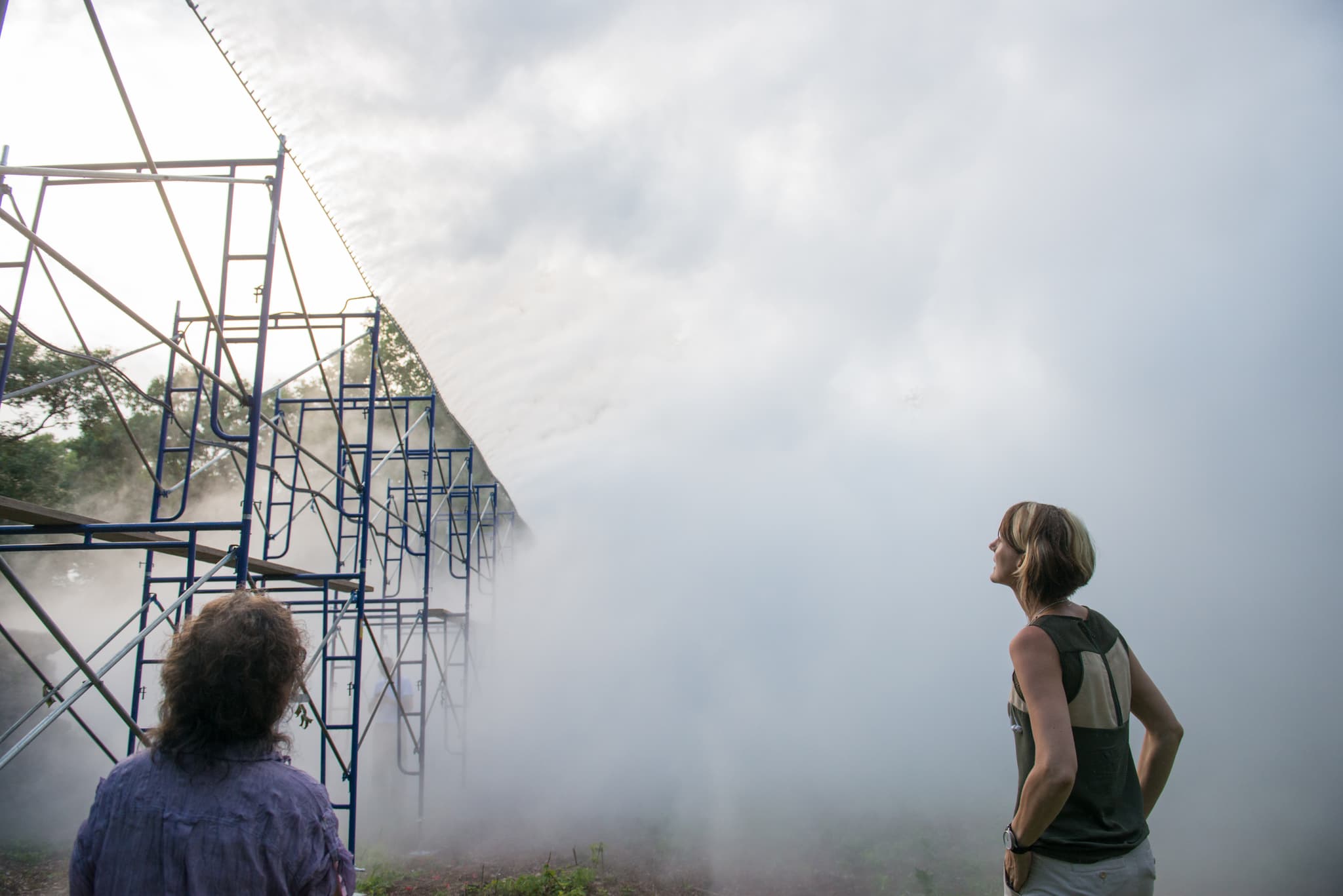
Fujiko Nakaya, with Jen Mergel, testing her fog sculpture Fog x Ruins in Franklin Park, Boston, 2018. Image by Melissa Ostrow. Courtesy of the Emerald Necklace Conservancy.
Situated in locations from the Back Bay Fens to the north and the Arnold Arboretum and Franklin Park to the south, each of the sites were selected through equal parts research and topographical exploration. The full names of the five installations each include the number #72509, the internationally recognized code for Boston’s weather station. Using data from the past decade collected from this tower, Nakaya creates sculptures that are weather-responsive and climate aware. Though the wind and weather patterns are crucial to the engineering of Nakaya’s installations, as an artist, she is far more interested in the ever-changing dialogue between the sculptures and their environment. She is in essence, a sculptor of contingencies.
Upon the consideration of space, Mergel explained Nakaya’s process of surveying the land to site her works using her body to feel the conditions. In order to better understand the site, she would move with through intention and listen carefully to sense environmental patterns. “When we were walking around the Emerald Necklace last October,” Mergel recalls, “Fujiko walked circles around me, really scouting on the move. But then she would stop at a spot and stand still for minutes. I wasn’t sure completely sure what she was doing. In the middle of this, she turned and asked, ‘Does the wind always come from this direction?’ A question to which I threw up my hands and laughed, explaining that in New England, we never know which direction the weather comes from.”
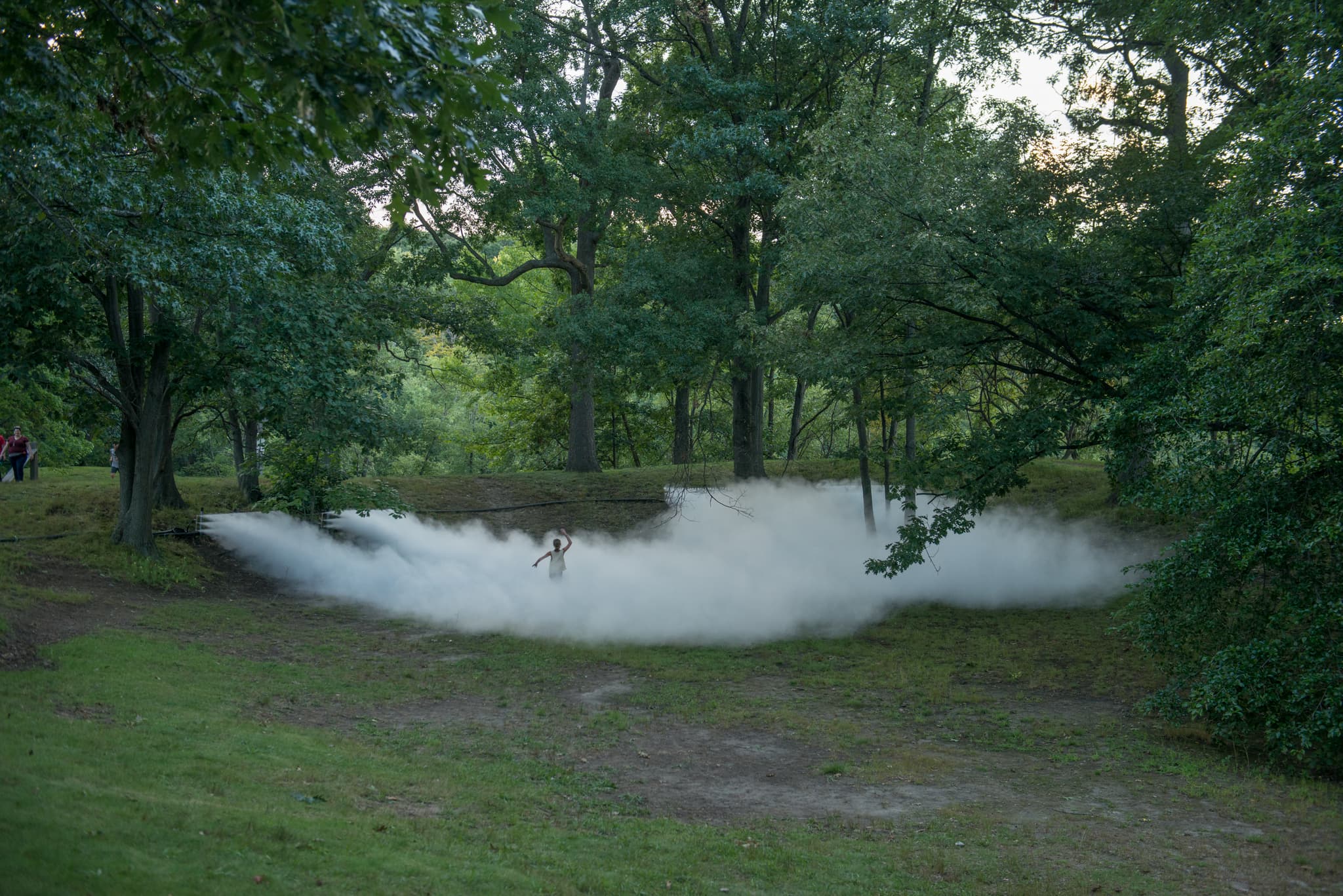
Fog x Beach, Jamaica Pond, Boston, 2018. Image by Melissa Ostrow. Courtesy of Emerald Necklace Conservancy.
Mergel draws an analogy between Nakaya’s installations and that of a jazz musician. “She has built the instrument and then mastered it, though remaining improvisatory, her mastery lies in her responsive tendencies.” There are several uncontrollable factors in Nakaya’s work that act as interconnected contingent elements. Yet, rather than attempting to control them, Nakaya positions the installations as ever-evolving happenings where no two moments are alike. Ephemeral in nature, yet calculated in practice, her work creates a stage upon which the fog can perform.
Beyond the forces of nature that are present, humans and animals come to play a significant role in each installation. The presence of figures in the work creates a reflexive structure that is constantly shifting and responding. In turn, the viewer is simultaneously an onlooker and an element within the piece.
Despite the mastery of elusive mediums and moments, Fujiko Nakaya remains humble and continuously eager to learn. When asked to recall her proudest moment, Nakaya instead turned to the power within these contingent environments. “In each installation,” she points out, “I find something new and surprising contained within nature. It is through experimentation and observation, that I have become fortunate to learn some of nature’s laws.”
Nakaya is the daughter of renowned and revered Japanese scientist Ukichiro Nakaya, who is credited with pioneering the field of glaciology and creating the first artificial snowflake in 1936.(4) Though initially concerned with formal processes of composition and decomposition in painting, Fujiko Nakaya’s work has always exhibited a fascination with the sublime force of nature and science—a trait which she attributes to her relationship with her father. In her early work, she carefully studied cloud formations through the removal of paint with turpentine on canvas. It was a process of studying growth and decay, but also of pushing formal practices in painting akin to the philosophies of her father, who famously said “to understand ice you have to listen to ice.”
Nakaya has always positioned herself as a collaborator. In 1968, Nakaya began working with E.A.T., or, Experiments in Art and Technology. This pioneering gathering of artists, scientists, and organizers was developed in 1966 with Bell Laboratories. The organization itself seems like something of avant-garde lore. Founded by engineer Billy Kluver and artist Robert Rauschenberg, E.A.T. sought to foster collaboration and break down the silos between innovation, industry, and art. Nakaya became an integral member of the group, participating in a series of performances called “9 Evenings: Theater & Engineering” with the New York vanguard of 1960s artists. She had first met Robert Rauschenberg, Merce Cunningham, and John Cage in 1964 when Cunningham’s dance company performed in Tokyo (5). When E.A.T. took shape four years later, Nakaya quickly became a crucial collaborator, advocate, and leader in the emerging fields of experimental and performance based art.
By 1968, Nakaya had become the project manager for E.A.T. in Japan where she coordinated performances and exhibitions with artists from around the globe. Already experimenting with water and vapors, she was approached by Kluver to develop a fog sculpture which could cover the dome of the Pepsi Pavillion at the 1970 Osaka Expo. Working to capture the same sensation and effect of real fog, Nakaya lamented that she, “tried every nozzle on the market, but most produced droplets that were too large and too wet.” She even admitted that for a time she considered the idea impossible, seeing that no one was interested in developing the proper mechanism. From the very beginning, Nakaya was insistent that “the fog droplets had to be natural in size, bountiful, and made from safe water without any chemicals.”
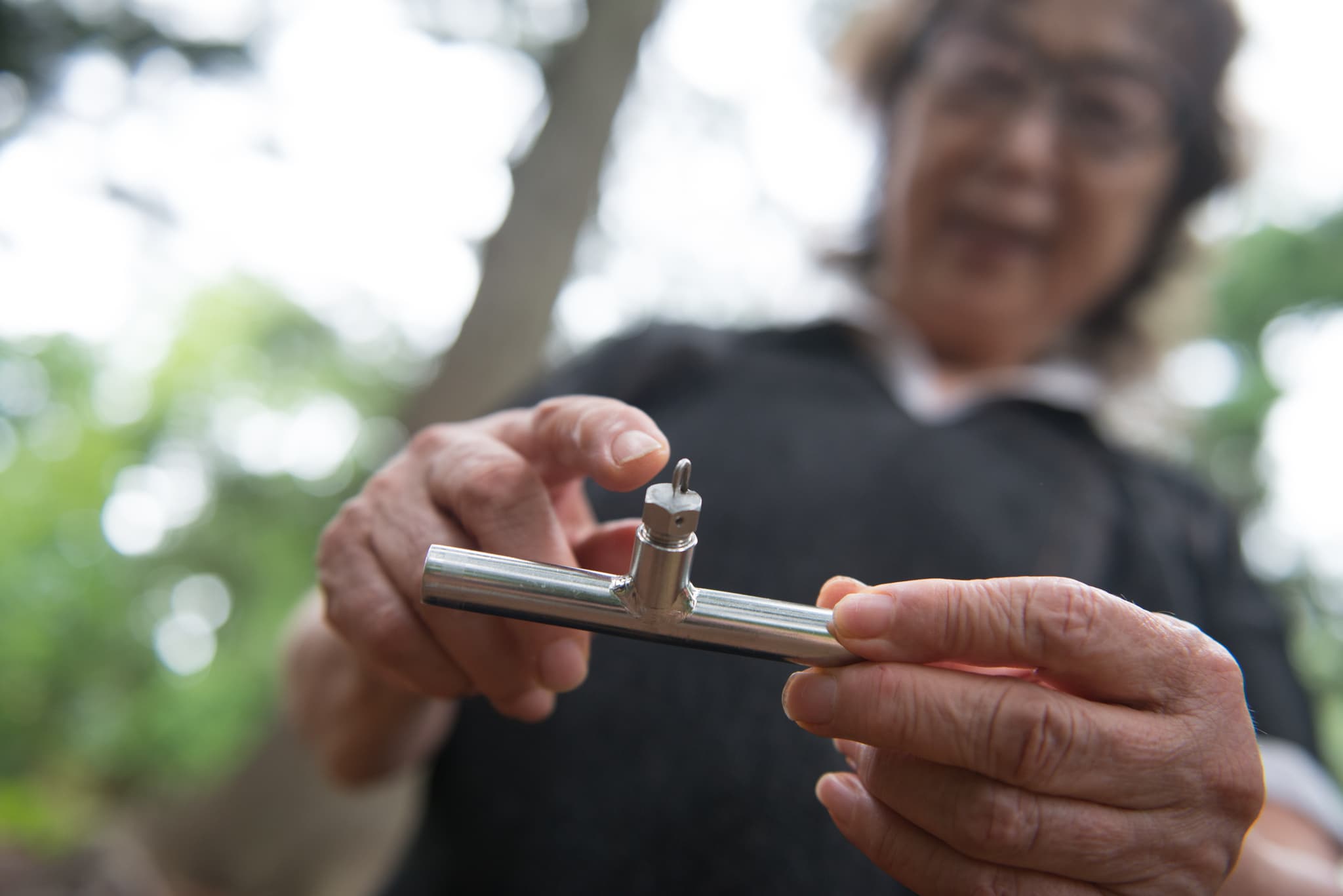
Fujiko Nakaya and fog nozzle, Arnold Arboretum, Boston, 2018. Image by Melissa Ostrow courtesy of Emerald Necklace Conservancy.
Nakaya was shocked when Billy Kluver announced that he had found an engineer in California who could develop the proper nozzle. That same week, Nakaya was off to Los Angeles to meet with the engineer, Thomas Mee, who she was told had the technology she was looking for. They tested the nozzle in Mee’s front yard, just outside of Pasadena. Always considering composition, Nakaya recalled the initial obscurity of the fog’s shape, positing “it really should have been more round.” This moment, however, marked a shift for Nakaya, proving that her vision of creating an immersive fog structure, sans chemicals, was indeed possible.
For her first installation, 2,200 individual nozzles were installed and meticulously controlled at the Pepsi Pavilion in Osaka. Drawings from 1969 illustrate Nakaya’s measured considerations of the space as she depicted the precise angle at which the knobs should be positioned based on wind conditions, weather patterns, and potential interferences. These drawings highlight the nexus of Nakaya’s process as a balance between careful calculations and unforeseen phenomena creating a platform for natural sensations. Focused on the interaction between her art and its immediate environment, Nakaya regards her personal process as an act of constant experimentation. “Nature is very honest,” she admits, “I try to remain an observer, so in creating these installations, I want to let out just enough fog so that the interaction with nature can occur.”
The resulting installations become a ground for interplay. Her work plays on notions of theater— the kind that Rosalind Krauss might call “environmental [or] tableau sculpture.” (6) Rather than acting as a master of medium, Nakaya takes on the role of a conductor, responding to ever-evolving environments. She employs a kind of genius-loci in her sculptures that momentarily take hold of a space by the pervasiveness of form — an act which stands in opposition to the heavy handed, and overtly masculine permanence of Robert Smithson or Donald Judd’s sculptures from the same era. Instead, Nakaya’s fog sculptures are experiments in space, where distortion and revelation are constantly at odds with one another.
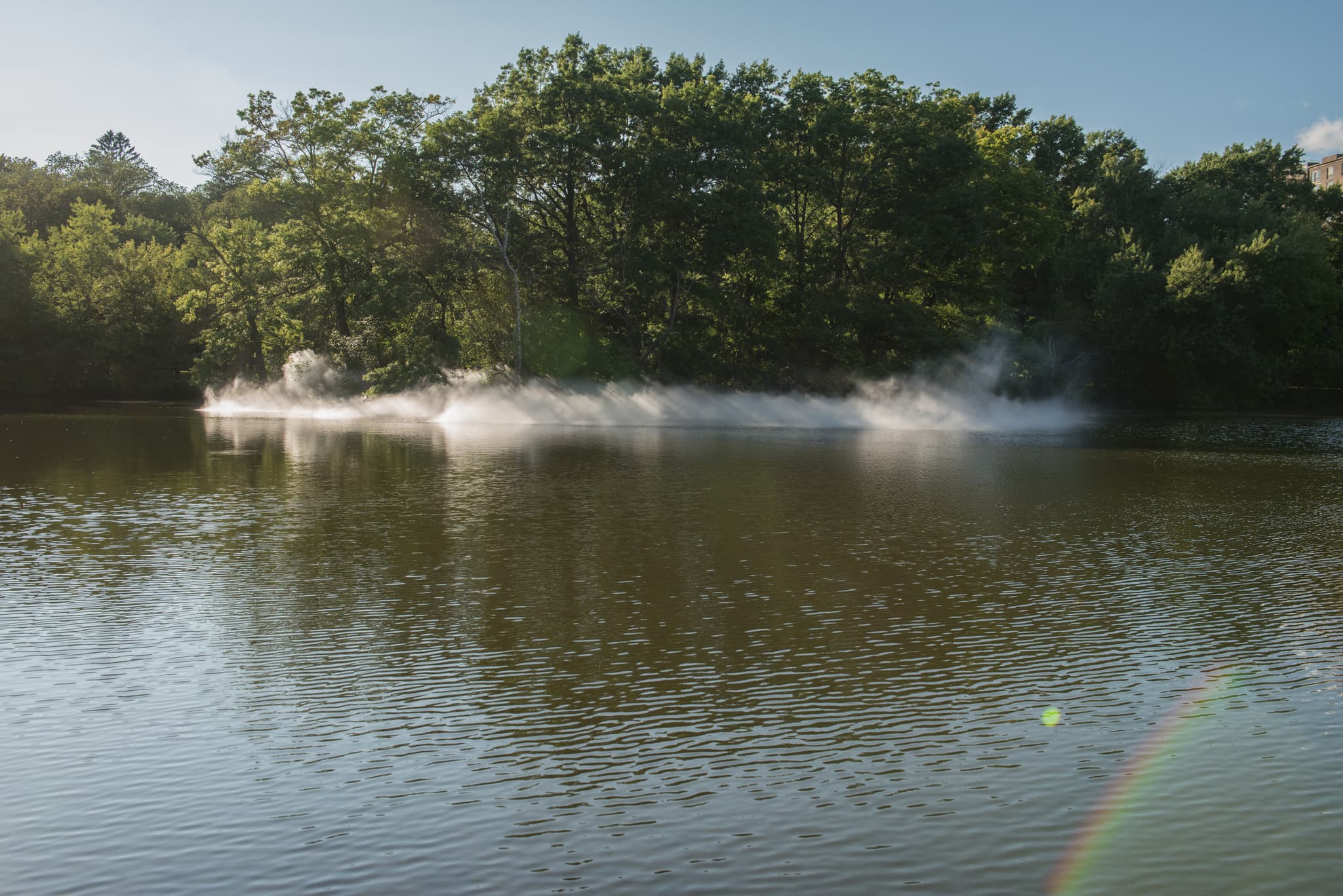
Fog x FLO’s Fog x Island, Leverett Pond, Boston, 2018. Image by Melissa Ostrow courtesy of Emerald Necklace Conservancy.
Artist and critic, Kenjiro Okazaki, is the director of a project called “Kagakuukan.” It is a joint venture between Kaga-City, Ishikawa Prefecture, and the Nakaya Ukichiro Foundation to “explore collaboration between the natural sciences and the arts,” but it has also become one of the few great collections of discourse and writing surrounding Fujiko Nakaya’s work. Here, he speaks to the relationship between forces in Nakaya’s sculptures:
“Time and space, distance and latency overflow therein; we are enwrapped and find ourselves astonished (generating oneself for the other, and as the other), discovering ultimately that the “fog” indeed had existed therein. In other words, the observing “subject” and the observed “fog,” along with “space” and “time” wherein they both exist, are all tentative concepts generated by this self-reflexive structure.” (7)
Even decades after her first installation, Nakaya’s practice in facilitating natural interactions continues to evolve. Along the Emerald Necklace, no two sculptures are alike. Atop Jamaica Pond, a fog slowly creeps in and sits peacefully on the water. At Franklin Park, however, a raised scaffold, lighting, and on the weekends, music, form a reimagined structure within landmarked ruins of a building designed in local Roxbury puddingstone by Olmsted. The calculated nature of Nakaya’s practice is evident as fog rolls from a treetop in the Arnold Arboretum sinking to the ground and swirling cool air around one’s ankles. The body only recognizes the presence of fog once you are already surrounded. It creeps in from the direction of the wind, visible at a distance, and suddenly, you are completely enveloped.
It is not enough to see the phenomena that nature presents, we must also feel it. Thick against the skin, heavy inside the breath, and cool to the touch, it is an act of illusion typically reserved to nature. In Nakaya’s sculptures however, the distortion of the fog acts instead as a platform for exploration. Existing within the chaos of uncontrolled environments, Nakaya insists her sculptures are really just an act of listening — a claim intrinsically linked to the very nature of her being.
1 Kwon, Miwon, (1997). “One Place after Another: Notes on Site Specificity.” October, 80, 85. doi:10.2307/77880
2 Buskirk, M. (2005). The contingent object of contemporary art. Cambridge, MA: MIT.
3 Leigh Markopoulos’ Mutable Environments, positions Nakaya’s work as “Existing somewhere between “experience-oriented” sculpture, environment, and performance” but also connects her work to ‘systems and process art’ of the 1960’s
4 Henry Urbach and Thomas Rockwell, Over the Water: Fujiko Nakaya, edited by Marina McDougall and Leigh Markopoulos. Exploratorium, 2013, Exhibition Catalogue, accessed 17 August 2018, https://www.exploratorium.edu/files/arts/over-the-water-catalog.pdf
5 Seblay, A. (2014, November 4). “The Merce Cunningham Dance Company’s Last Stop in Tokyo,1964” [Editorial]. Post At MoMA. Retrieved from https://post.at.moma.org/content_items/497-the-merce-cunningham-dance-company-s-last-stop-in-tokyo-1964
6 Krauss, R. (1977). Passages in Modern Sculpture. New York, NY: The Viking Press
7 Okazaki, K. (2017, September 19). The lucid, unclouded fog—the movement of bright and swinging water particles. [Editorial]. Kagakuukan. https://kagakuukan.org/eng/archive/the-lucid-unclouded-fog
“Fog x FLO: Fujiko Nakaya on the Emerald Necklace” is currently on view at five locations in the Emerald Necklace and runs through Oct. 31. For more information, maps, and hours, visit the Emerald Necklace Conservancy site.
